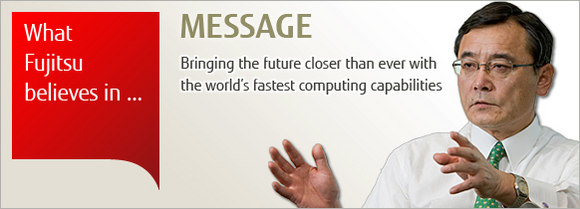Archived content
NOTE: this is an archived page and the content is likely to be out of date.
What Fujitsu Believes in...
President and Representative Director
Masami Yamamoto
Happy New Year. I hope this year is a good one for all of us. I would like to start off by talking about supercomputers. Displayed here is an image of the certificate for achieving the No. 1 ranking among the world’s TOP500 supercomputers, with computing performance of over 10 petaflops, an important milestone for humanity. Computing performance of 10 petaflops enables us to close in on such fundamental questions as the nature of life and the origin of the universe, and may also hold the potential to contribute to the sustainable development of humanity.
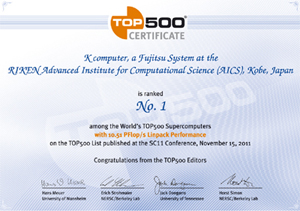
As the world’s third-largest ICT services company, Fujitsu focuses on how to use ICT to contribute to society and the daily lives of people around the world, but the company has also long been a supercomputer manufacturer. In fact, Fujitsu has a history of supercomputer development going back more than 30 years, and on two occasions in the past has been the company behind the world’s fastest supercomputer, a claim not many companies can make. The K computer, which is the supercomputer developed in collaboration with RIKEN, achieved the No. 1 position in the in the TOP500 ranking of supercomputers in June of last year, and again in November, with the world’s best LINPACK benchmark performance. Also in November, it held the top spot in all four divisions of the HPC Challenge, and won the Gordon Bell Prize, for six honors in all.
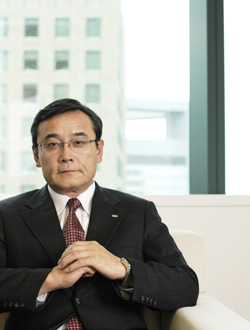
In supercomputer development, it is easy to focus one’s attention on performance rankings, but what we really have in mind when we are working to develop the world’s fastest computers is how to bring a future of unprecedented human achievement as close as possible through the power of technology. It is an expression of our commitment to bringing about a prosperous future that fulfills the dreams of people throughout the world by helping to solve the many challenges facing the world. Simulations run on supercomputers are one of the keys to unlocking that future. It is only with the world’s most advanced supercomputing power that we can get the most advanced glimpse of a sustainable future. The analytic results produced by the world’s most powerful computing capabilities give us immediate insights into humanity’s potential that could be gleaned nowhere else in the world. All of us at Fujitsu are committed to carry on the work of using supercomputers to solve the many problems facing society and to open new avenues for human achievement. We will continue to take on the challenge of leveraging the power of ICT to create a prosperous future that fulfills the dreams of people throughout the world.
Computing the Ideal Future
Helping keep people safe and secure through the Virtual Japan project
Masahiko Yamada, General Manager, TC Solutions Division
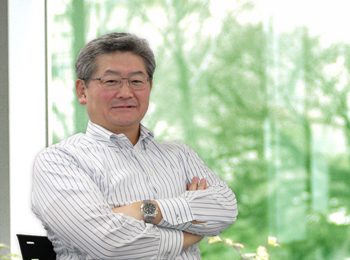
Since the dawn of history, human progress has continually been driven forward by striving to bring about a future anticipated in the dreams of mankind. The sundials and great ruins of ancient civilizations show that, even then, each era’s most advanced technologies have been used to try to divine the future as accurately as possible. Now, with supercomputers, that dream of mankind since antiquity is starting to become a reality.
There is some dispute over the origins of computing, but the world’s first and most famous general-purpose computer, ENIAC (*), was developed during World War II to calculate ballistic trajectories. Afterwards, computers were employed to raise the efficiency of office work, and since then they have made dramatic leaps in performance. Today, with our computers linked together over the Internet, they have become an indispensable part of life and the informational foundation of every business sector. While some might wonder why any further advancement in computers is needed, from my perspective, computers are barely past the starting line in the drive to achieve their true purpose.
Last year’s massive earthquake has left deep scars on Japan. And, with the subsequent floods in Thailand and the earthquake in Turkey, natural disasters continue to occur through the world. In predicting and mitigating damage and helping create a sustainable society, there is much more that ICT can contribute. We are at the point where we can say that we mostly understand the mechanisms underlying the emergence of tsunamis. Supercomputer simulations ought to be helpful both in predicting damage and responding to it if it happens. But some issues need to be resolved before this can be put into practice. One is the need for highly detailed topographic and ocean-floor data. Another is the fact that supercomputers still do not have the necessary processing power. The performance of supercomputers in general use today is limited to simulations with a granularity of several cubic kilometers. This is sufficient for predicting the approximate path of a wave. To run analyses of where people should evacuate or where seawalls need to be constructed to be most effective, however, this level of processing power is still insufficient. The level of granularity required to be useful in driving decisions on proper human responses is probably at least on the order of several dozen meters. If so, just in terms of plain calculations, that would require computing performance that is one million times more powerful than current levels.
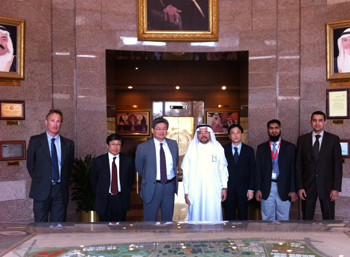 an image of KAU (King Abdulaziz University), Saudi Arabia and Masahiko Yamada
an image of KAU (King Abdulaziz University), Saudi Arabia and Masahiko Yamada
an image of KAU (King Abdulaziz University), Saudi Arabia and Masahiko Yamada
I believe that we are only now getting to the point where, beyond merely making human work more efficient, computers can begin to play a new role in which they perform tasks that would be impossible to achieve any other way, such as simulations. That is precisely the door that the K has opened. The era in which ICT helps to protect humanity and bring about a more sustainable future has just dawned.
I am interested in building a virtual representation of Japan as a way to create a more sustainable society. This would include actual topography, buildings, structures, subways, underground passages, power grid, and gas lines, etc., representing a virtual Japan in three dimensions. This could yield new benefits that we cannot even imagine today. If a major city is hit by a tsunami, what will happen to clusters of tall buildings? What kinds of disruptions will blocked roads cause? How will water run through underground passages? And what would be an ideal urban design for minimizing damage. At the very least, it should be possible to prepare secure evacuation centers and determine safe transit routes. And a virtual Japan like this would obviously have business potential far beyond these applications.
I am confident that the day for this will come, sooner or later. There are, however, important issues that need to be overcome. The agencies that hold the data on Japan’s maps, topography, buildings, and seafloor are all siloed, and integrating their data will be difficult. Because data on electric, gas, and subway lines are all assets held by private companies, any integrated management and use of them will be extremely difficult. And we will probably need to create simple, accurate three-dimensional sensing technology, and then make it practical and commonplace. I want to go beyond the framework of a conventional ICT company to create a virtual Japan. This would be an enormous undertaking that may take several decades, but I want to hold onto this dream while devoting my energies to bringing about the creation of sustainable cities based on ICT.
Of course, there are many other problems in the world that need solving. From developing new drugs for end-stage cancer treatments, to developing advanced materials for eco-cities and understanding the mysteries of the cosmos, there are issues common to all of humanity in a wide range of fields that supercomputers may held to resolve. In manufacturing, as well, supercomputers are already critical resources, and their importance is only going to increase. The era in which the speed of a supercomputer is a key determinant in the competitiveness of a company’s product development efforts is right around the corner.
Before 1960, ENIAC, the world’s first general-purpose computer, which required 17,468 vacuum tubes, was the subject of much debate. People said it would not work, or that it was a waste of money. But it turned out to be a pivotal moment that led to the modern communications age. The K computer that RIKEN and Fujitsu developed together is the world’s fastest, but its real achievements are yet to come. A few decades from now, supercomputers will be critical infrastructure for ensuring a safe, secure, and sustainable society. There would be no greater joy for me than being able at that time to look back on the K computer and see its development as another pivotal moment.
To bring the future a step closer and leverage the power of ICT to advance human knowledge, Fujitsu will continue its commitment to extending the limits of technology as it works to bring about a prosperous future that fulfills the dreams of people throughout the world.
* ENIAC: Electronic Numerical Integrator and Computer. The first electronic computer, developed in the US.
MESSAGE (2.66 MB )
Fujitsu developed the MESSAGE to share our thoughts to contribute to the sustainability of society.
